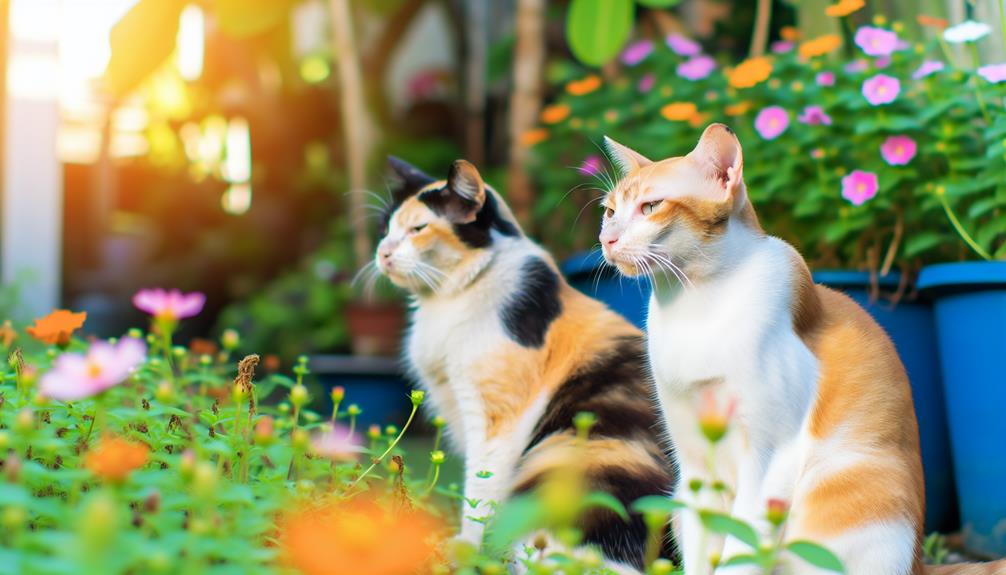You might have heard the common belief that orange cats are always male, but is that really true? It's a fascinating topic that dives into the genetics of feline coat colors. The orange coloration is tied to a gene on the X chromosome, which makes the situation a bit more complicated than it seems. While it's true that the majority of orange cats are male, female orange cats do exist, albeit less frequently. So, why is this the case, and what does it mean for the orange cats you see roaming around? Let's explore this intriguing genetic puzzle further.
Genetics of Feline Coat Colors
In understanding the genetics of feline coat colors, it is vital to recognize that the color of a cat's fur is primarily determined by the genes inherited from its parents. This genetic inheritance plays a pivotal role in the manifestation of coat color variations observed in domestic cats. Genes located on various chromosomes encode specific pigments and patterns, giving rise to the vast array of feline coat colors.
You will find that the primary pigments responsible for coat color are eumelanin and pheomelanin. Eumelanin results in black or brown fur, while pheomelanin produces red or yellow hues. The specific combination and expression of these pigments are controlled by multiple genes. Key among them is the melanocortin 1 receptor (MC1R) gene, which influences the type of melanin produced. Mutations in these genes can lead to different coat color variations.
In addition to pigment-related genes, modifier genes can alter the intensity and distribution of colors. For instance, the agouti gene (ASIP) affects whether the fur has a banded pattern or a solid color. A cat's genotype at the agouti locus can determine if its coat will exhibit a tabby pattern or a more uniform coloration.
It's also essential to take into account the influence of epistasis, where one gene can mask or modify the expression of another gene. This interaction greatly contributes to the diversity seen in feline coat colors.
The Role of Chromosomes
Understanding the role of chromosomes in feline coat color genetics is crucial for comprehending the underlying mechanisms of color inheritance. Chromosome inheritance plays a pivotal role in determining whether a cat will express certain colors, including the orange coat. In felines, the gene responsible for orange coloring is located on the X chromosome. This is a classic example of sex-linked traits, where the gene's expression is influenced by the sex chromosomes.
In cats, females have two X chromosomes (XX), while males possess one X and one Y chromosome (XY). For a female cat to display an orange coat, both of her X chromosomes must carry the orange allele; otherwise, the presence of a non-orange allele on one X chromosome will result in a different coat color. Conversely, a male cat requires only one X chromosome with the orange allele to exhibit the orange coat, since the Y chromosome does not carry any coat color genes.
This disparity in chromosome inheritance explains why a higher proportion of orange cats are male. The probability of a male inheriting the orange allele is inherently higher because they have only one X chromosome that can carry the trait. The mechanics of sex-linked traits guarantee that males have a 50% chance of being orange if their mother carries the orange allele, whereas females have a lower probability due to the need for both X chromosomes to carry the allele.
Common Misconceptions

Despite widespread information on feline genetics, numerous misconceptions about orange cats and their gender persist. These misunderstandings can lead to confusion and perpetuate gender stereotypes. To clarify, it is crucial to address these common fallacies with evidence-based explanations.
Firstly, many believe that orange cats are always male. This misconception stems from the higher prevalence of male orange cats compared to females, due to the genetic mechanism involving the X chromosome. However, the existence of female orange cats, though less common, unequivocally disproves this assumption.
Secondly, you might think that cat popularity influences the perception of gender. High-visibility orange male cats in media and culture contribute to the stereotype, but this doesn't reflect the actual genetic distribution. The portrayal of orange male cats in movies and advertisements reinforces the notion that orange cats are mainly male, skewing public perception.
Thirdly, some individuals hold the belief that the coat color of a cat directly determines its gender traits or personality. This assumption lacks scientific foundation. While certain traits can be more common in specific coat colors due to breeding practices, there is no empirical evidence linking coat color with specific gender traits or behaviors.
Consider these points to evoke a deeper understanding:
- Misleading Media: Cultural portrayals reinforce the idea that all orange cats are male.
- Genetic Basics: Misinterpreting genetic principles can foster incorrect beliefs.
- Personality Myths: Attributing personality traits to coat color lacks scientific support.
Female Orange Cats
Although less frequently observed, female orange cats do exist and their occurrence is a result of specific genetic combinations. The orange coloration in cats is linked to the X chromosome, where the gene responsible for the orange fur is located. Because females have two X chromosomes (XX), they require two copies of the orange gene to exhibit the orange coat color. This genetic requirement makes female orange cats considerably rarer compared to their male counterparts, who only need one copy of the orange gene (XY).
In rare instances, a female orange cat inherits the orange gene from both parents, leading to the manifestation of the orange coat. This dual inheritance is less probable due to the distribution of the orange gene across the general feline population. Statistically, it is estimated that only about 20% of orange cats are female, underscoring their relative rarity in the cat population.
For a female orange cat to be born, both parent cats must carry and pass on the orange gene. This genetic scenario necessitates that the mother cat be either orange herself or a carrier of the orange gene, and the father must be orange. Such specific genetic conditions contribute to the limited frequency of female orange cats.
The complexity of X-linked genetic determination in cats explains why these female orange cats are exceptional cases. Understanding the genetics behind coat color can demystify why you're less likely to encounter a female orange cat compared to a male. To sum up, while female orange cats are rare instances, their existence is a fascinating example of genetic inheritance and chromosomal interaction.
Celebrating Orange Cats

The allure of orange cats lies in their distinctive coat color, making them a subject of both admiration and scientific curiosity. In evaluating the celebratory aspects of these felines, it's crucial to reflect on their unique traits and the cultural impact they've had. Orange cat personalities are often described as sociable and affectionate, a hypothesis supported by anecdotal evidence and owner testimonials.
Firstly, let's examine notable orange cats in popular culture, which have greatly influenced public perception:
- Garfield: This iconic comic strip character epitomizes the lazy yet lovable cat, contributing to the archetype of orange cat personalities.
- Morris the Cat: As the advertising mascot for 9Lives cat food, Morris has been an enduring figure, reinforcing the friendly and approachable demeanor often associated with orange cats.
- Orangey (Rhubarb): This feline actor starred in several films, demonstrating not only the aesthetic appeal of orange cats but their versatility and trainability.
From a genetic standpoint, the orange coloration is due to the presence of the pheomelanin pigment, a topic of interest within the field of feline genetics. This pigment results from a mutation in the MC1R gene, further solidifying the special status of these cats.
You'll find that many owners report orange cats as having more outgoing and gregarious behaviors, though it's important to note that such claims are largely subjective and lack rigorous scientific validation. However, these perceptions contribute to the broader cultural celebration of orange cats, making them not only a fascinating subject for genetic study but also cherished companions in many households.
Conclusion
You've explored the genetics behind feline coat colors and the role of chromosomes, debunking common misconceptions. Coincidentally, while the majority of orange cats are male due to the X-linked gene, female orange cats do exist, albeit rarely. This rarity stems from requiring two copies of the orange gene. Consequently, celebrating orange cats should include acknowledging the unique genetic combinations that produce these fascinating felines, both male and female.
